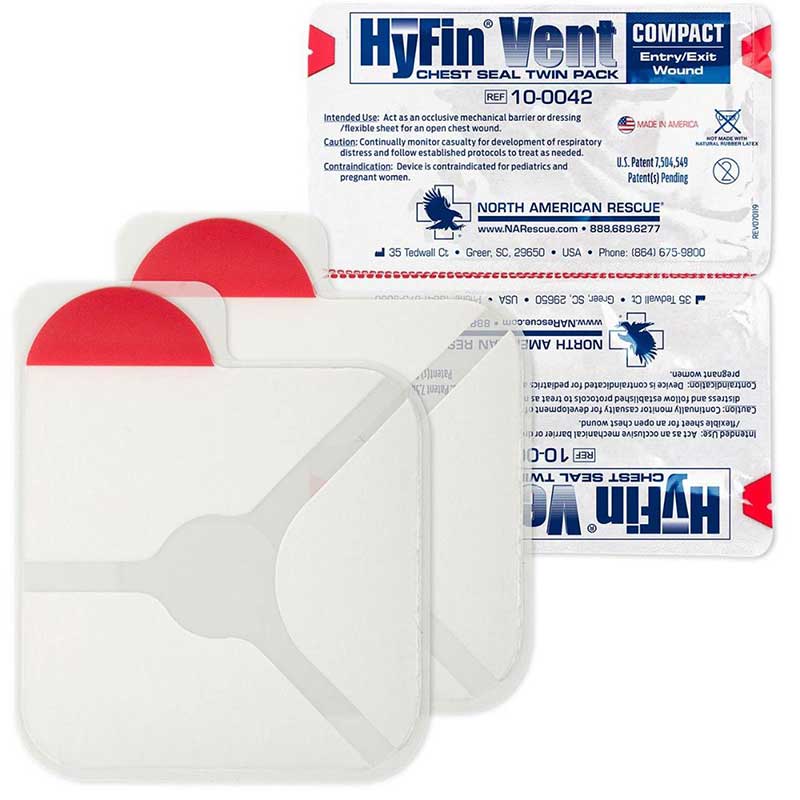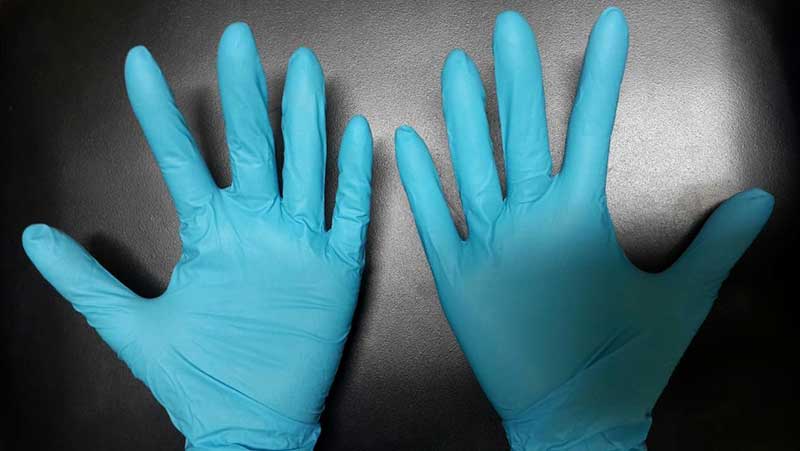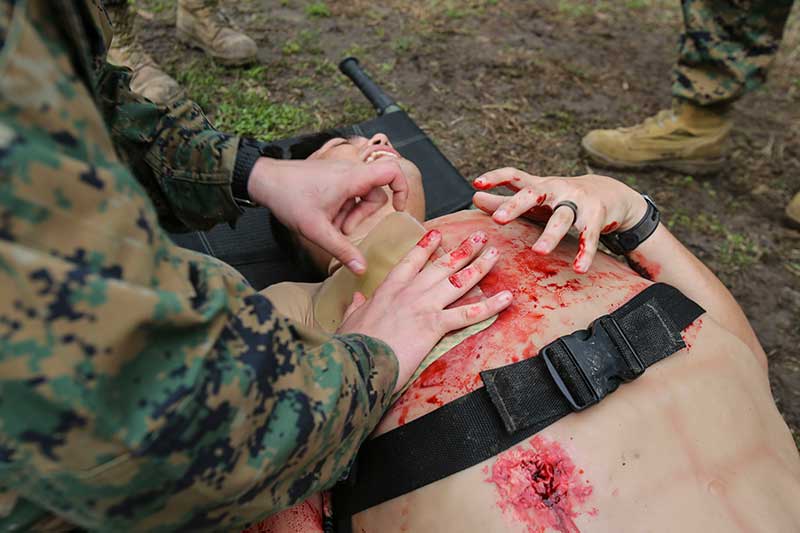
AC-022021-Chest-CS-1-800
With an open chest wound, the victim may develop tension pneumothorax. Tension pneumothorax is the second leading cause of preventable trauma deaths on the battlefield. It is the progressive build-up of air within the pleural space between the lung and the chest wall.
As the air in the pleural space builds up, the pressure in the space increases and begins to collapse the lung on the injured side. This results in less air that can be exchanged for perfusion in the lung. Once the lung has collapsed, pressure begins to compress the heart, shifting the mediastinum (membrane between the lungs) toward the uninjured side. This shift is known as mediastinal shift.
Carry at least two chest seals to treat both entrance and
exit wounds. Always check for exit wounds.
Although tension pneumothorax normally develops over one to two hours, it can develop rapidly. It’s 100% fatal if not treated. The only treatment when it occurs is a needle thoracostomy (needle decompression) performed by skilled medical personnel.
OCCLUSIVE DRESSINGS
Laypersons can treat penetrating chest injuries (sucking chest wounds) by the application of an occlusive dressing. These chest seals may slow the development of tension pneumothorax and allow for better breathing. All penetrating chest wounds need to be treated. They are used on any penetrating injuries from collarbone to naval (belly button) on all four sides of the thorax.
Carry at least two chest seals to treat both entrance and exit wounds. Always check for exit wounds. Chest seals take up little space in the kit. Multiple gunshot wounds to the chest are common in shootings. You will need to treat all of them.
The chest seals will only buy time. The victim will eventually require a chest tube and surgery.

Occlusive dressings are designed to form a barrier and prevent outside air from entering the pleural cavity from an open pneumothorax (sucking chest wound). All open and/or sucking chest wounds should be treated by immediately applying a chest seal. Photo: North American Rescue.

Nitrile (latex-free) gloves for protection from blood-borne diseases are essential. Gloves are the first thing on and the last thing off. Photo: Praewnaaaaaam.
Occlusive dressings are designed to form a barrier and prevent outside air from entering the pleural cavity from an open pneumothorax (sucking chest wound). Many types of occlusive dressings are available, including the HALO® Chest Seal, HyFin® Chest Seal, Asherman Chest Seal (ACS), FOX Chest Seal, Bolin Chest Seal, and Vaseline® Gauze. Field expedient occlusive dressings can also easily be made.
Vented and non-vented chest seals are available. Which is better? As a result of animal studies, the Committee on Tactical Combat Casualty Care (CoTCCC) Guidelines now specify the use of a vented chest seal as first choice.
Current TCCC Guidelines as of 1 August 2019 state: “All open and/or sucking chest wounds should be treated by immediately applying a vented chest seal to cover the defect. If a vented chest seal is not available, use a non-vented chest seal. Monitor the casualty for the potential development of a subsequent tension pneumothorax. If the casualty develops increasing hypoxia, respiratory distress, or hypotension and a tension pneumothorax is suspected, treat by burping or removing the dressing or by needle decompression.”
Although used by the armed forces, the ACS doesn’t stick as well as the newer designs. It uses a “flutter valve” to vent and the valve is prone to clogging.
Field expedient occlusive dressings can be made from
anything non-porous and bigger than the entry and
exit wounds. Use a bandage or adhesive tape to secure.
I keep North American Rescue HyFin Vent Compact Chest Seals in my every day carry (EDC) trauma kit. HyFin Chest Seals are available in two sizes Standard and Compact. They come in a twin pack and vented and non-vented. HyFin Chest seals are currently in use by AFSOC Pararescue.
HyFin Vent Chest Seals feature three-channel pressure relief vents, as well as an advanced gel adhesive that sticks well to blood, sweat, and hair. They has a large red tab for quick peel-and-stick application and “burping” the seal if needed. They additionally feature a transparent backing that is designed to allow easy placement directly over the wound and to easily conform to the casualty’s chest.
Field expedient occlusive dressings can be made from anything non-porous and bigger than the entry and exit wounds. Use a bandage or adhesive tape to secure. Adhesive tape may not stick well in bloody or soiled conditions.
Always access for hemorrhage and airway patency first. Wipe away blood and apply seal. Placing the victim injured side down is common place or in position of comfort. No matter what type of occlusive device is applied, always carefully monitor the victim for any signs or symptoms of tension pneumothorax.
SIGNS & SYMPTOMS OF TENSION PNEUMOTHORAX
Tension pneumothorax results in decreased circulatory and respiratory function. The victim will have increasing difficulty in breathing. The breathing will become very laborious and the rate will increase. Chest rise and fall will become unequal.
Jugular vein distension (JVD) is another sign of tension pneumothorax. It occurs when increased pressure of the superior vena cava (vein that returns blood from the upper body to the right atrium of the heart) causes the jugular veins to bulge. It is most visible on the right side of the neck, appearing as a bulge running down the right side of the victim’s neck.

A U.S. Navy hospital corpsman simulates applying a chest seal to a gunshot wound during training exercise. Although corpsman is not wearing gloves in photo, protective gloves and protective eyewear should always be worn when rendering aid to a bleeding victim.
As tension pneumothorax progresses, the trachea may deviate from the midline, pointing away from the injured side. This is a late sign.
This article has only touched on the basics. Training is essential. There are a number of excellent training courses being offered around the country.
One that I have taken and can personally recommend, is the two-day Dark Angel Medical Direct Action Response Training (D.A.R.T.) course. It is offered at various locations around the country. Suffice it to say it is an outstanding course. Dark Angel Medical also offers free online training that covers the basics, as well as a wide range of trauma kits, as well as components.
The online learning platform Deployed Medicine is also a great training resource for TCCC. Used by the Defense Health Agency (DHA) “to trial new innovative learning models aimed at improving readiness and performance of deployed military medical personnel,” it’s free and you don’t have to be a member of the military to take advantage of it. I suggest that you check it out.
Dark Angel Medical
www.darkangelmedical.com
Deployed Medicine
www.deployedmedicine.com
















